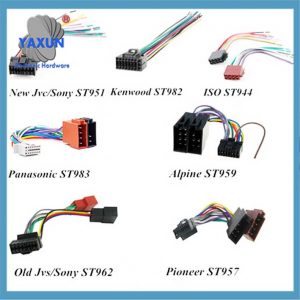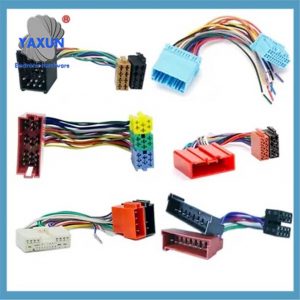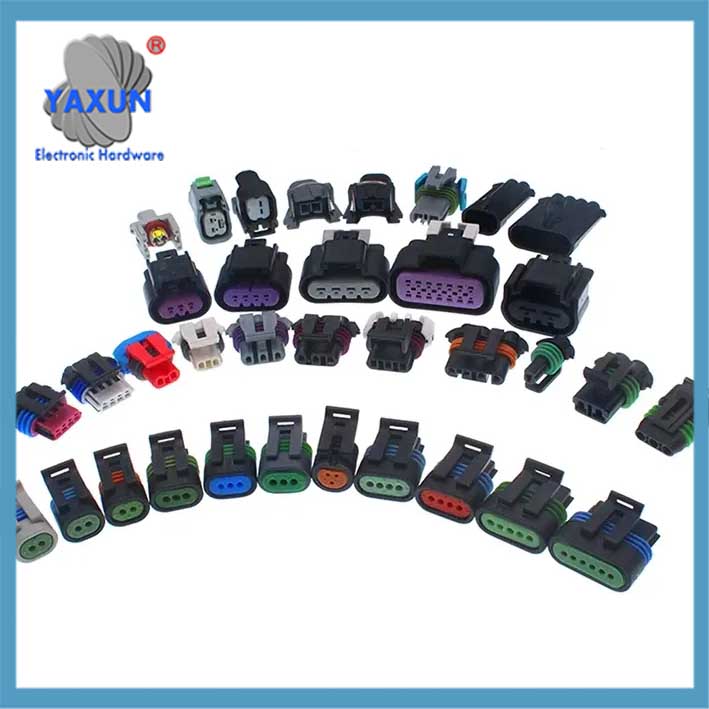The so-called automotive functional wiring harness semi-finished products mainly refer to antenna wiring harness (GPS, TV, mobile phone…), HSD wiring harness (video cable, USB cable, LVDS…), air bag wiring harness, usw.
 Good quality car auto audio, radio wire harnesses,Connectors Manufacturer |
 Automotive wiring harness type and selection method- Wiring duct, Cable Gland, Cable Tie, Terminals |
 20 Pin Plug to 6 x 3.5mm RCA Female Car Stereo Audio Adapter Cable Wiring Wire – Wiring Harness |
For Mazda 2 2003 ->
For Mazda 3 2003 ->
For Mazda 323 / Sedan 2001 ->
For Mazda 5 2005 ->
For Mazda 6 2002 ->
For Mazda 626 2001 -2002
For Mazda B-Series 1999 ->
For Mazda BT 50 2006 ->
For Mazda CX -7 2006 ->
For Mazda Demio 2001 ->
For Mazda MPV 2001 ->
For Mazda MX-5 2001 ->
For Mazda Millenia 2001 ->
For Mazda MPV 2001 ->
For Mazda Premacy 2001 ->
For Mazda Protégé 2001 -2005
For Mazda RX-8 2003 ->
For Mazda Tribute 2001 ->
For Mazda Xedos 2001 ->

Correct positioning method of automobile wiring harness connector
Generally speaking, the procurement cycle of semi-finished products is relatively long, while the cycle of domestic suppliers is relatively short, and the cycle of many well-known suppliers even takes up to 3 months. daher, regarding the length of semi-finished products, we must combine the procurement cycle and assembly time points to provide timely and accurate information to suppliers to ensure that semi-finished products can meet equipment requirements in a timely manner.
When the semi-finished product is assembled in the wiring harness factory, if the semi-finished product is too long, we can change the wiring and direction, or exceed the drawing branch tolerance. But if it is short, it will affect the assembly. daher, we generally require suppliers to maintain correct tolerances (of course each factory can control it by itself).
Different loading stages have different requirements for semi-finished products:
1 – Prototype verification stage
In the prototype stage, the requirements for the length of semi-finished products are not very strict, and more emphasis is placed on electrical skills. Gleichzeitig, there are many engineering changes in the prototype stage, which will greatly affect the length of the semi-finished product. So we usually leave a certain amount of length. Allgemein, the antenna and HSD lines are 100mm longer than the length on the customer’s drawing, the air bag line is 500mm longer, and the water pipe is 200mm longer.
2 – First verification of mass production stage
In the first verification stage, there are certain requirements for the accuracy of the length of the semi-finished product. It is best for the wiring harness supplier to be able to meet the semi-finished product length requirements on the customer’s drawings. If not, the deviation needs to be reported to the customer. Jedoch, there will still be many changes from the first verification stage to the mass production stage, and we should also leave a certain length of time. The length reserved at this time is a little less than at the prototype stage. You can reserve 30mm for the antenna and HSD cable, 200mm for the air bag cable, and 100mm for the water pipe.
3 – Medium-volume trial production stage
This is the last stage before mass production. In some OEMs, the cars at this time can already be sold internally. Generally speaking, the length of semi-finished products at this time is basically the same as the length of mass production, so the length of semi-finished products must be strictly controlled at this stage.
1. Antenna, HSD: These are signal lines and cannot be bent or wound in the wire harness, so the length requirements are very strict. We generally take the theoretical length from the customer’s drawing and require the supplier to follow the correct tolerance. Don’t worry about the semi-finished product being too long, because general wire harness suppliers will require a positive tolerance of 0-10mm at both ends of the wire harness. Gleichzeitig, a little size can be eaten up by the fork joints of the tooling plate. But for an antenna with a connector at one end and cut off at the other end (the wire harness factory strips and crimps the terminals by itself), we also need to reserve the length of the stripping and crimping terminals.
2. Air bag wire: Air bag wire is generally relatively thin and soft, so it can be easily bent and wound in the wire harness without much impact on the signal. Jedoch, when we were close to mass production, we finally used the previous airbag line (which was too long) to go to the tooling board for trial assembly and verification. After the length difference is found, the air bag line length is updated. If crimping terminals are required at the end of the air bag wire, the length of the stripped crimping terminals must also be reserved.
4 – Wiring harness mass production stage
In the mass production stage, the production of wire harness suppliers and semi-finished product suppliers has been relatively stable, and a certain amount will be pre-produced to meet delivery requirements. There will be very few engineering changes at this time, if any, it will be a relatively complicated process. Engineering changes are mainly divided into two types: one is natural change and the other is forced change.
1. Natural switching: Natural change means that both the old and new states can be used, and the new state can be used after the old state is used up. The losses caused by this kind of change are relatively small, and the OEMs and suppliers at all levels are more willing to accept it. Natural switching generally occurs during optimization in the later stages of mass production, annual model changes, usw.
2. Forced switching: Forced switching means that the old state cannot be used and the new state must be used. At this time, we need to consider many aspects. First, how to deal with the old inventory of wire harness suppliers and semi-finished product suppliers. Suppliers generally charge customers for the production of used materials. In fact, it depends on whether new materials can be supplied in time to meet customers’ assembly and loading needs. Furthermore, how to control the new and old status of the supplier and the customer, and how to deal with the cars on the market. daher, forced switching is rare and usually occurs only when major problems occur.
In general, even the length of the semi-finished product of the wiring harness is too long. We can eat up a certain length by changing the wiring order, crossing the fork up and down, bending and winding, usw. Jedoch, this will consume more time, affect the efficiency of the production line, and affect the quality of the wire harness. daher, we should optimize the length of semi-finished products in advance to ensure the efficiency of the production line and the quality of the wire harness. I think this is what every wiring harness factory wants.
Types of Wiring Harnesses:
Engine Harness:
Connects the engine’s electrical components like sensors, ignition system, and alternator.
Body Harness:
Handles electrical connections for interior and exterior features like lights, entertainment systems, and safety features.
Powertrain Harness:
Facilitates smooth operation of the powertrain system by transmitting power and signals between the transmission and engine components.
HVAC Harness:
Controls the climate within the vehicle by connecting blower motors, evaporator, condenser, and A/C compressors.
Autonomous Driving Harness:
Designed for the specific needs of autonomous driving, handling large amounts of data and ensuring reliability and safety.
Optical Harness:
Transmits large amounts of data without being affected by electromagnetic noise.
Wiring Harness for Sliding Doors:
Convey electric power and signals to electrical components within sliding doors.
Antenna Harness:
Connects the antenna to the receiver, conveying radio, TV, telephone, GPS, and other signals.
Instrument Panel Harness
Connects the various electrical components on the instrument panel, such as combined instruments, air conditioner switches, receivers, cigarette lighters, usw.
Specialized Harnesses
For specific systems, like lights, air conditioning, or car communication systems.
Functions of Wiring Harnesses:
Power Transmission:
Conducts electrical power from the battery to various components.
Signal Transmission:
Transmits signals between the car’s electronic control units (ECUs) and other components.
Organization and Protection:
Organizes wires into a neat and manageable structure, protecting them from damage and ensuring efficient wiring.
Connectors:
Connects electrical lines to components, allowing for easy connection and disconnection.
Safety:
Ensures the safe and reliable operation of the vehicle’s electrical systems.
 English
English العربية
العربية Български
Български Čeština
Čeština Dansk
Dansk Nederlands
Nederlands Suomi
Suomi Français
Français Deutsch
Deutsch Magyar
Magyar Italiano
Italiano 日本語
日本語 한국어
한국어 Português
Português Română
Română Русский
Русский Slovenščina
Slovenščina Español
Español Svenska
Svenska Tiếng Việt
Tiếng Việt
